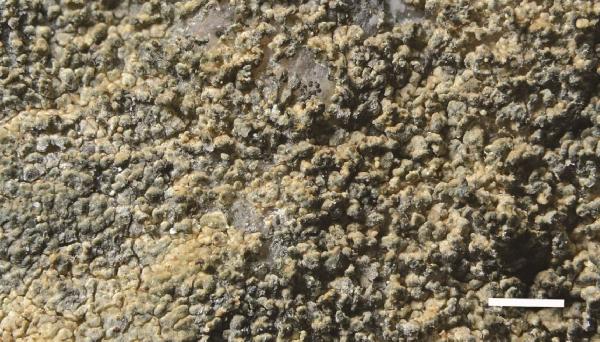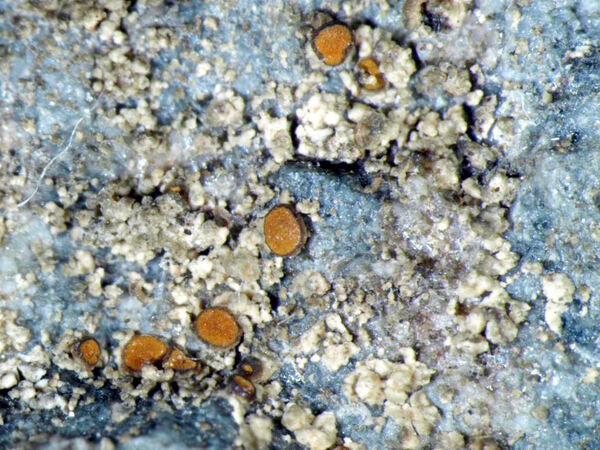Caloplaca squamuloisidiata van den Boom & V.J. Rico
Lichenologist, 38: 530, 2006.
Synonyms:
Distribution: C - Sar (Herb. Vondrák nr. 9605).
Description: Thallus crustose, episubstratic, areolate, up to 0.5(-0.8) mm thick, pale to very dark grey or almost black in sun-forms, usually with a bluish tinge, often delimited by a narrow, black prothallus. Areoles at first convex, then flat, up to 2 mm wide, isidiate; isidia arising mainly from margins, but soon covering the whole surface, globose to shortly elongated and almost coralloid, concolorous with thallus, in average 82 μm. Cortex paraplectenchymatous; medulla poorly developed. Apothecia lecanorine, up to 1.3(-1.5) mm across, sessile, with a flat to slightly convex, pale to dark orange disc and a thick, raised, sometimes crenulate or isidiate thalline margin. Proper exciple indistinct, up to 10 μm thick, prosoplectenchymatous; epithecium orange, with inspersed granules, K+ purple-red; hymenium colourless, 55-85 μm high; paraphyses simple to sparingly branched in upper part, c. 2 μm thick at base, the uppermost cells slightly swollen, 3(-5) μm wide; hypothecium colourless. Asci 8-spored, clavate, functionally unitunicate, apically thickened with a broad internal beak, the inner part of apex and external cap I+ blue, Teloschistes-type. Ascospores 2-celled, polarilocular, hyaline, ellipsoid, 10-15 x 5-8 μm, the equatorial thickening (“septum”) 3-7 μm (c. 1/3 of spore length). Pycnidia rare, immersed. Conidia bacilliform, c. 3 x 1 μm. Photobiont chlorococcoid. Spot tests: thallus K- or K+ faintly violet, C- or C+ violet, KC-, P-; disc of apothecia K+ purple-red. Chemistry: thallus with the Sedifolia-grey pigment; disc of apothecia with parietin (major), fallacinal, emodin, teloschistin and parietinic acid (minor). Note: a recently-described species, hitherto known from the Iberian Peninsula and Sardinia, characterised by a squamulose, isidiate thallus. It grows on rather shaded, steeply inclined to rain-sheltered surfaces of siliceous rocks. The sample from Sardinia was collected in the Gennargentu Massif near Fonni, on the northern slopes of Mt. Spada, at c. 1450 m. According to Vondrák (in litt.) the species does not belong to Caloplaca s.str.
Growth form: Crustose
Substrata: rocks
Photobiont: green algae other than Trentepohlia
Reproductive strategy: mainly asexual, by isidia, or isidia-like structures (e.g. schizidia)
Commonnes-rarity: (info)
Alpine belt: absent
Subalpine belt: absent
Oromediterranean belt: very rare
Montane belt: very rare
Submediterranean belt: very rare
Padanian area: absent
Humid submediterranean belt: very rare
Humid mediterranean belt: absent
Dry mediterranean belt: absent

Predictive model

Source: Arup, U., Blom, H. H. & Lindblom, L. 2021. The Gaupne area in Sogn og Fjordane – a hot-spot for lichens in Norway. Graphis Scripta 33 (3): 31–49. Oslo. ISSN 2002-4495. - CC BY-4.0
Caloplaca squamuloisidiata. A sterile thallus showing the scabrous, beige to dark bluish grey surface.
Arup L18404 (LD). Bar = 1 mm
Growth form: Crustose
Substrata: rocks
Photobiont: green algae other than Trentepohlia
Reproductive strategy: mainly asexual, by isidia, or isidia-like structures (e.g. schizidia)
Commonnes-rarity: (info)
Alpine belt: absent
Subalpine belt: absent
Oromediterranean belt: very rare
Montane belt: very rare
Submediterranean belt: very rare
Padanian area: absent
Humid submediterranean belt: very rare
Humid mediterranean belt: absent
Dry mediterranean belt: absent

Predictive model

 INDEX FUNGORUM
INDEX FUNGORUM
 GBIF
GBIF


